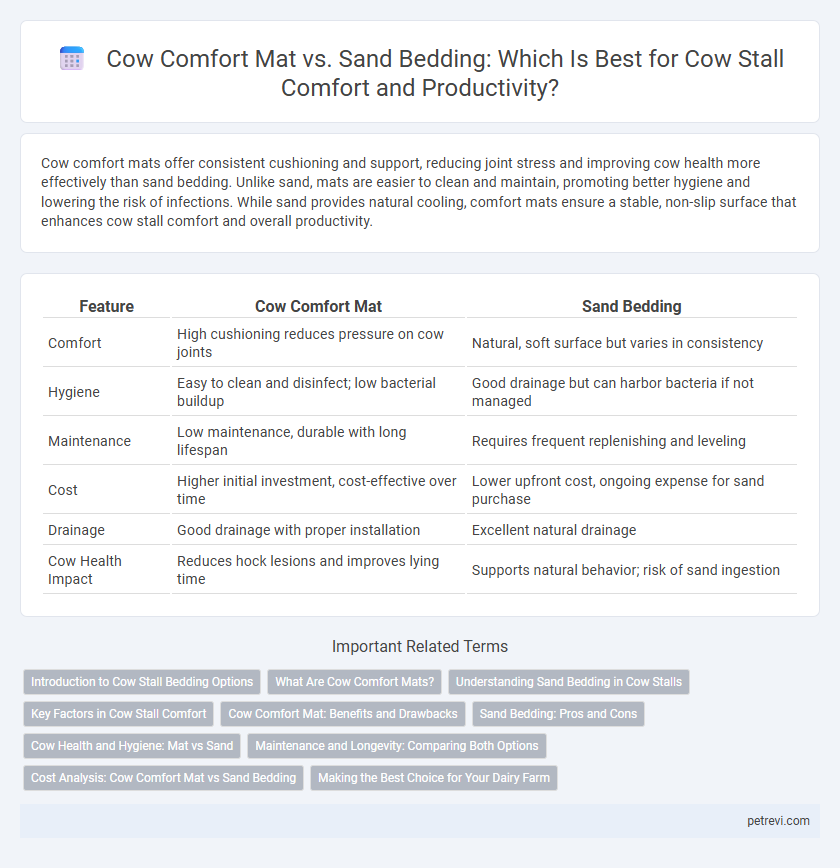Cow comfort mats offer consistent cushioning and support, reducing joint stress and improving cow health more effectively than sand bedding. Unlike sand, mats are easier to clean and maintain, promoting better hygiene and lowering the risk of infections. While sand provides natural cooling, comfort mats ensure a stable, non-slip surface that enhances cow stall comfort and overall productivity.
Table of Comparison
| Feature | Cow Comfort Mat | Sand Bedding |
|---|---|---|
| Comfort | High cushioning reduces pressure on cow joints | Natural, soft surface but varies in consistency |
| Hygiene | Easy to clean and disinfect; low bacterial buildup | Good drainage but can harbor bacteria if not managed |
| Maintenance | Low maintenance, durable with long lifespan | Requires frequent replenishing and leveling |
| Cost | Higher initial investment, cost-effective over time | Lower upfront cost, ongoing expense for sand purchase |
| Drainage | Good drainage with proper installation | Excellent natural drainage |
| Cow Health Impact | Reduces hock lesions and improves lying time | Supports natural behavior; risk of sand ingestion |
Introduction to Cow Stall Bedding Options
Cow stall bedding options like cow comfort mats and sand bedding play a crucial role in enhancing dairy cow welfare and productivity. Cow comfort mats provide a cushioned, durable surface that reduces joint stress and improves cow lying time, while sand bedding offers excellent moisture absorption and natural comfort, promoting udder health by minimizing mastitis risk. Choosing the right bedding depends on factors such as cost, farm management practices, and environmental conditions to optimize cow comfort and dairy efficiency.
What Are Cow Comfort Mats?
Cow comfort mats are durable rubber mats designed to provide cushioning and support in cow stalls, enhancing hoof health and reducing joint stress. Unlike sand bedding, which offers natural softness and improved drainage, comfort mats offer consistent firmness and ease of cleaning, leading to better hygiene management. Both options influence cow comfort, behavior, and milk production, but comfort mats excel in stall longevity and ease of maintenance.
Understanding Sand Bedding in Cow Stalls
Sand bedding in cow stalls offers superior cow comfort by providing excellent moisture drainage and reducing the risk of mastitis compared to other materials. It conforms to the cow's body, promoting better rest and reducing pressure sores, which enhances overall cow welfare and productivity. Proper maintenance and regular topping of sand bedding ensure a clean, hygienic environment that supports cow health and longevity.
Key Factors in Cow Stall Comfort
Cow comfort mats provide consistent cushioning and reduce pressure points, improving overall cow health and lying time. Sand bedding offers natural drainage and superior moisture control, minimizing bacterial growth and hoof problems. Key factors for stall comfort include durability, hygiene, thermal regulation, and cow preference, where mats excel in support and sand in cleanliness.
Cow Comfort Mat: Benefits and Drawbacks
Cow comfort mats offer durable, shock-absorbing surfaces that enhance cow welfare by reducing joint stress and improving rest quality compared to sand bedding. These mats provide consistent cleanliness and ease of maintenance, minimizing labor and lowering the risk of mastitis infections. However, comfort mats can incur higher upfront costs and may retain moisture if not properly designed, potentially affecting overall udder health.
Sand Bedding: Pros and Cons
Sand bedding offers cows excellent traction and helps reduce hoof problems by providing a firm, non-slip surface that supports cow comfort. It allows for better drainage and moisture control, minimizing bacterial growth and lowering mastitis risk. However, sand can be abrasive to equipment, requires frequent replacement, and may lead to increased labor and costs compared to softer bedding options.
Cow Health and Hygiene: Mat vs Sand
Cow comfort mats provide a cushioned surface that reduces joint stress and promotes better hoof health, while sand bedding offers excellent drainage and natural microbial balance that helps control mastitis and other infections. Mats can be easier to clean and maintain consistent hygiene levels, but sand's natural properties enhance cow cleanliness by allowing manure to settle below the surface, reducing bacterial load. Optimal health outcomes depend on balancing comfort from mats with the hygienic benefits of sand, ensuring a dry, clean resting environment for cows.
Maintenance and Longevity: Comparing Both Options
Cow comfort mats require less frequent replacement and simpler cleaning routines, making them a low-maintenance option for dairy farms. Sand bedding demands daily raking and thorough removal of waste to maintain hygiene, which can be labor-intensive but offers excellent longevity if managed properly. Both materials influence cow health and stall durability differently, with mats potentially reducing joint strain and sand providing superior drainage.
Cost Analysis: Cow Comfort Mat vs Sand Bedding
Cow comfort mats typically incur higher upfront costs compared to sand bedding but offer durability and reduced maintenance expenses over time. Sand bedding requires continuous replenishment and can increase labor costs due to frequent cleaning and replacement needs. Evaluating long-term financial impact, cow comfort mats may provide cost savings through improved cow health and decreased stall maintenance.
Making the Best Choice for Your Dairy Farm
Choosing between cow comfort mats and sand bedding significantly impacts cow health and dairy farm productivity. Cow comfort mats provide consistent cushioning and promote hoof health by reducing pressure points, whereas sand bedding offers natural traction and better moisture absorption, minimizing mastitis risk. Analyzing stall maintenance requirements, cow preference, and local climate conditions helps in selecting the optimal bedding for maximizing milk yield and animal welfare.
Cow Comfort Mat vs Sand Bedding for Cow Stall Bedding Infographic

 petrevi.com
petrevi.com